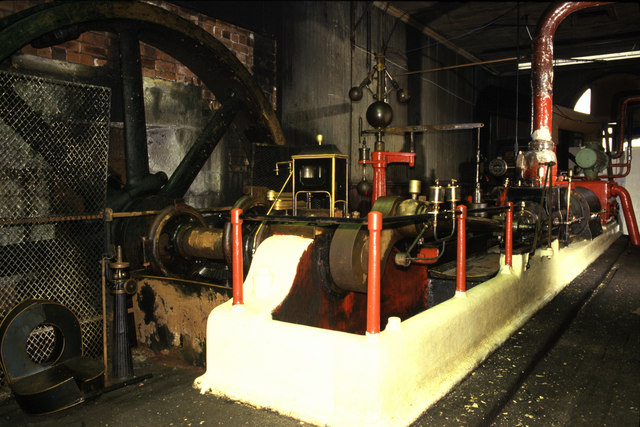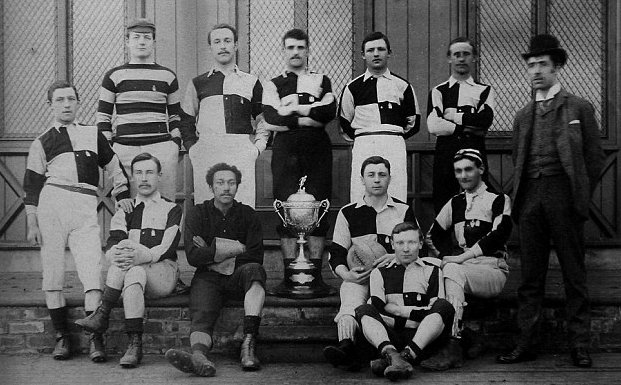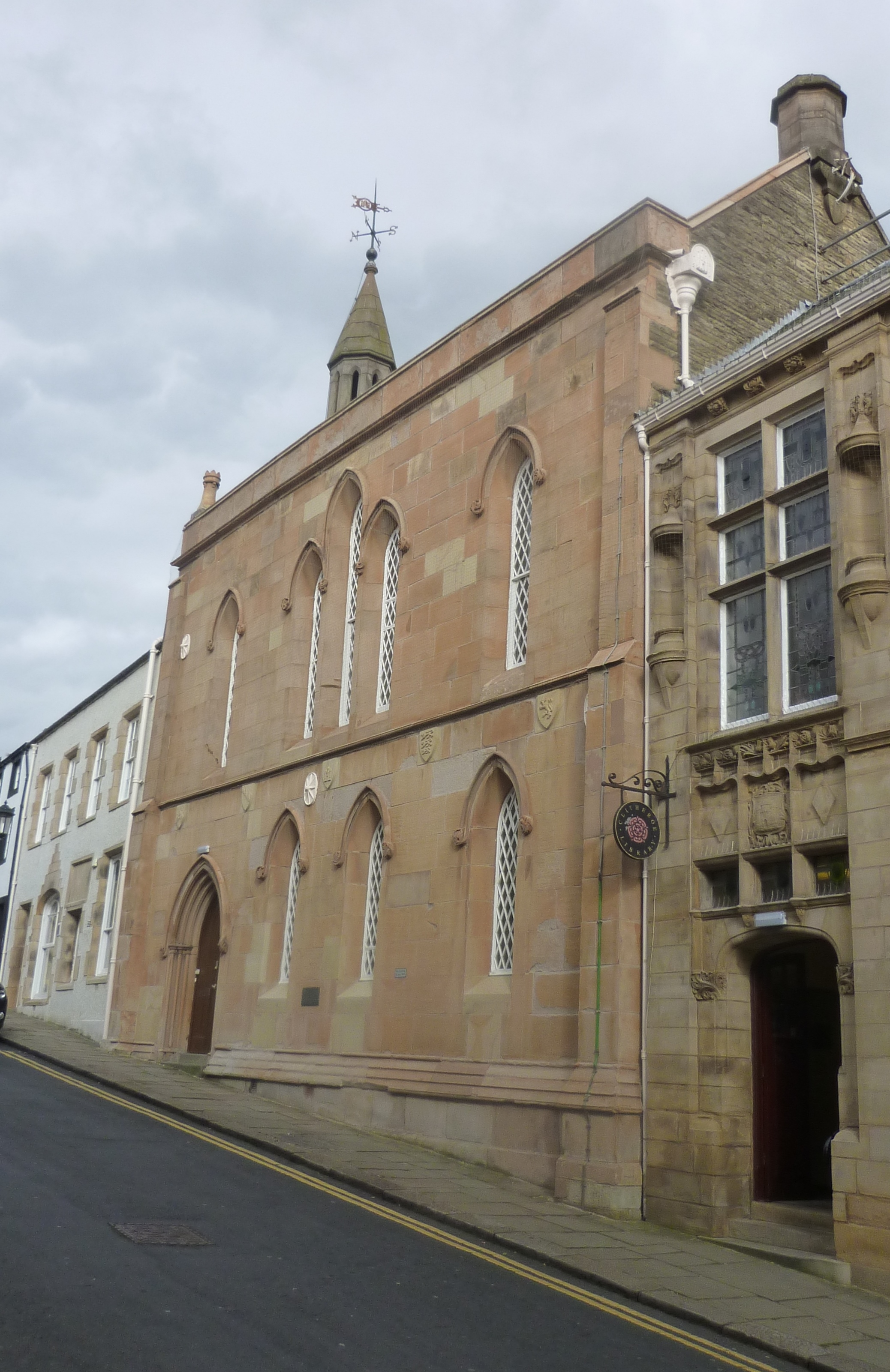|
2013–14 FA Trophy
The 2013–14 FA Trophy was the 44th season of the FA Trophy, the Football Association's cup competition for teams at levels 5–8 of the English football league system. A total of 276 clubs entered the competition, which was won by Cambridge United, who beat Gosport Borough 4–0 in front of 18,120 spectators at Wembley. Calendar Preliminary round Ties will be played on 5 October 2013. † – After extra time First round qualifying Ties will be played on 19 October 2013. Teams from Premier Division of Southern League, Northern Premier League and Isthmian League entered in this round. † – After extra time Second round qualifying Ties will be played on 2 November 2013 † – After extra time Third round qualifying Ties will be played on 16 November 2013. This round is the first in which Conference North and South teams join the competition. † – After extra time First round Ties will be played on 30 November 2013. This round is the first ... [...More Info...] [...Related Items...] OR: [Wikipedia] [Google] [Baidu] |
Cambridge United F
Cambridge ( ) is a university city and the county town in Cambridgeshire, England. It is located on the River Cam approximately north of London. As of the 2021 United Kingdom census, the population of Cambridge was 145,700. Cambridge became an important trading centre during the Roman and Viking ages, and there is archaeological evidence of settlement in the area as early as the Bronze Age. The first town charters were granted in the 12th century, although modern city status was not officially conferred until 1951. The city is most famous as the home of the University of Cambridge, which was founded in 1209 and consistently ranks among the best universities in the world. The buildings of the university include King's College Chapel, Cavendish Laboratory, and the Cambridge University Library, one of the largest legal deposit libraries in the world. The city's skyline is dominated by several college buildings, along with the spire of the Our Lady and the English Martyrs Ch ... [...More Info...] [...Related Items...] OR: [Wikipedia] [Google] [Baidu] |
Ramsbottom United F
Ramsbottom is a market town in the Metropolitan Borough of Bury, Greater Manchester, England. The population at the 2011 census was 17,872. Historically in Lancashire, it is on the River Irwell in the West Pennine Moors, northwest of Bury, and of Manchester. Its name is believed to derive from Old English and , meaning 'valley of the ram'. Its Victorian architecture, Pennine landscape and industrial heritage, including the East Lancashire Railway, contribute to heritage tourism in the town. History Toponymy The name either means 'ram's valley' from the Old English , 'a ram' and , 'a valley' but could mean a 'wild garlic valley', with the first element representing the Old English meaning 'wild garlic'. A record from 1324 recording the name as is inconclusive. The town was alternatively recorded as ''Ramysbothom'' in 1540. Early history Evidence of prehistoric human activity has been discovered in the hills surrounding the town. Early records show that in Norman tim ... [...More Info...] [...Related Items...] OR: [Wikipedia] [Google] [Baidu] |
Ossett Albion A
Ossett is a market town in the City of Wakefield metropolitan borough in West Yorkshire, England. Historically part of the West Riding of Yorkshire, it is situated between Dewsbury, Horbury and Wakefield. At the 2011 Census, the population was 21,231.https://www.nomisweb.co.uk/census/2011/ks101ew Census 2011 table KS101EW Usual resident population, West Yorkshire – Ossett BUASD, code E35000387 Ossett forms part of the Heavy Woollen District. History Toponymy The name ''Ossett'' derives from the Old English and is either "the fold of a man named Osla" or " a fold frequented by blackbirds". Ossett is sometimes misspelled as "Osset". In Ellis' ''On Early English Pronunciation'', one of the founding works of British linguistics, the incorrect spelling is used. The British Library has an online dialect study that uses the spelling. One new alternative theory is that it is the place where King Osbehrt died after receiving fatal wounds when fighting the Great Heathen Army of the ... [...More Info...] [...Related Items...] OR: [Wikipedia] [Google] [Baidu] |
Sheffield F
Sheffield is a city in South Yorkshire, England, whose name derives from the River Sheaf which runs through it. The city serves as the administrative centre of the City of Sheffield. It is historically part of the West Riding of Yorkshire and some of its southern suburbs were transferred from Derbyshire to the city council. It is the largest settlement in South Yorkshire. The city is in the eastern foothills of the Pennines and the valleys of the River Don with its four tributaries: the Loxley, the Porter Brook, the Rivelin and the Sheaf. Sixty-one per cent of Sheffield's entire area is green space and a third of the city lies within the Peak District national park. There are more than 250 parks, woodlands and gardens in the city, which is estimated to contain around 4.5 million trees. The city is south of Leeds, east of Manchester, and north of Nottingham. Sheffield played a crucial role in the Industrial Revolution, with many significant inventions and technologi ... [...More Info...] [...Related Items...] OR: [Wikipedia] [Google] [Baidu] |
Padiham F
Padiham ( ) is a town and civil parish on the River Calder, about west of Burnley, Lancashire, England. It forms part of the Borough of Burnley. Originally by the River Calder, it is edged by the foothills of Pendle Hill to the north-west and north-east. The United Kingdom Census 2011 gave a parish population of 10,098, estimated in 2019 at 10,138. History No prehistoric or Roman sites have been found in the built-up area. Padiham, though a name of Anglo-Saxon origin, is not recorded in the 1086 Domesday Book.Historic Town Assessment Report, Padiham, Lancashire County Council, May 2005, includes several old maps of the town and location ... [...More Info...] [...Related Items...] OR: [Wikipedia] [Google] [Baidu] |
Darlington 1883
Darlington Football Club is an association football club based in Darlington, County Durham, England. As of the 2022–23 season, the team competes in the National League North, at the sixth tier of English football. The club was founded in 1883, and played its matches at Feethams. The club originally played in regionally organised leagues, and was one of the founding members of the Northern League in 1889. They were first admitted to the Football League when the Third Division North was formed in 1921. They won the Third Division North title in 1925, and their 15th place in the Second Division in 1926 remains their highest ever league finish. After their admission to the League, they spent most of their history in the bottom tier. They won the Third Division North Cup in 1934, their first victory in nationally organised cup competition. They reached the last 16 of the FA Cup twice, and the quarter-final of the League Cup once, in 1968. In the early 1990s they won successive ... [...More Info...] [...Related Items...] OR: [Wikipedia] [Google] [Baidu] |
Ossett Town F
Ossett is a market town in the City of Wakefield metropolitan borough in West Yorkshire, England. Historic counties of England, Historically part of the West Riding of Yorkshire, it is situated between Dewsbury, Horbury and Wakefield. At the 2011 Census, the population was 21,231.https://www.nomisweb.co.uk/census/2011/ks101ew Census 2011 table KS101EW Usual resident population, West Yorkshire – Ossett BUASD, code E35000387 Ossett forms part of the Heavy Woollen District. History Toponymy The name ''Ossett'' derives from the Old English and is either "the fold of a man named Osla" or " a fold frequented by blackbirds". Ossett is sometimes misspelled as "Osset". In Ellis' ''On Early English Pronunciation'', one of the founding works of British linguistics, the incorrect spelling is used. The British Library has an online dialect study that uses the spelling. One new alternative theory is that it is the place where King Osbehrt died after receiving fatal wounds when fighting th ... [...More Info...] [...Related Items...] OR: [Wikipedia] [Google] [Baidu] |
Radcliffe Borough F
Radcliffe or Radcliff may refer to: Places * Radcliffe Line, a border between India and Pakistan United Kingdom * Radcliffe, Greater Manchester ** Radcliffe Tower, the remains of a medieval manor house in the town ** Radcliffe tram stop * Radcliffe, Northumberland * Radcliffe-on-Trent, Nottinghamshire ** Radcliffe railway station United States * Radcliffe, Iowa * Radcliff, Kentucky * Radcliffe, Lexington * Radcliff, Ohio Schools * Radcliffe College (1879–1999), a former women's college that was associated with Harvard University * Radcliffe Institute for Advanced Study (1999–present), a postgraduate study institute of Harvard University that has succeeded the former Radcliffe College * The Radcliffe School, a secondary school in Wolverton, Milton Keynes, England Other uses * Radcliffe (surname), including a list of people with the name * 1420 Radcliffe, a main-belt asteroid * Radcliffe baronets, a title in the Baronetage of the United Kingdom * Radcliffe Camer ... [...More Info...] [...Related Items...] OR: [Wikipedia] [Google] [Baidu] |
Clitheroe F
Clitheroe () is a town and civil parish in the Borough of Ribble Valley, Lancashire, England; it is located north-west of Manchester. It is near the Forest of Bowland and is often used as a base for tourists visiting the area. In 2018, the Clitheroe built-up area had an estimated population of 16,279. The town's most notable building is Clitheroe Castle, which is said to be one of the smallest Norman keeps in Great Britain. Several manufacturing companies have sites here, including Dugdale Nutrition, Hanson Cement, Johnson Matthey and Tarmac. History The name ''Clitheroe'' is thought to come from the Anglo-Saxon for "Rocky Hill", and was also spelled ''Clyderhow'' and ''Cletherwoode'', amongst others. The town was the administrative centre for the lands of the Honour of Clitheroe. The Battle of Clitheroe was fought in 1138 during the Anarchy. These lands were held by Roger de Poitou, who passed them to the De Lacy family, from whom they passed by marriage in 1310 or 1311 to ... [...More Info...] [...Related Items...] OR: [Wikipedia] [Google] [Baidu] |
Harrogate Railway Athletic F
Harrogate ( ) is a spa town and the administrative centre of the Borough of Harrogate in North Yorkshire, England. Historic counties of England, Historically in the West Riding of Yorkshire, the town is a tourist destination and its visitor attractions include its spa waters and Harlow Carr, RHS Harlow Carr gardens. away from the town centre is the Yorkshire Dales National Park and the Nidderdale AONB. Harrogate grew out of two smaller settlements, High Harrogate and Low Harrogate, in the 17th century. For three consecutive years (2013–2015), polls voted the town as "the happiest place to live" in Britain. Harrogate spa water contains iron, sulphur and common salt. The town became known as 'The English Spa' in the Georgian era, after its waters were discovered in the 16th century. In the 17th and 18th centuries its 'chalybeate' waters (containing iron) were a popular health treatment, and the influx of wealthy but sickly visitors contributed significantly to the wealth of th ... [...More Info...] [...Related Items...] OR: [Wikipedia] [Google] [Baidu] |
Wakefield F
Wakefield is a cathedral city in West Yorkshire, England located on the River Calder. The city had a population of 99,251 in the 2011 census.https://www.nomisweb.co.uk/census/2011/ks101ew Census 2011 table KS101EW Usual resident population, West Yorkshire – Wakefield BUASD, code E35000474 The city is the administrative centre of the wider City of Wakefield metropolitan district, which had a population of , the most populous district in England. It is part of the West Yorkshire Built-up Area and the Yorkshire and The Humber region. In 1888, it was one of the last group of towns to gain city status due to having a cathedral. The city has a town hall and county hall, as the former administrative centre of the city's county borough and metropolitan borough as well as county town to both the West Riding of Yorkshire and West Yorkshire, respectively. The Battle of Wakefield took place in the Wars of the Roses, and the city was a Royalist stronghold in the Civil War. Wakefiel ... [...More Info...] [...Related Items...] OR: [Wikipedia] [Google] [Baidu] |
Farsley A
Farsley is a town in the City of Leeds metropolitan borough, West Yorkshire, England to the west of Leeds city centre, east of Bradford. Farsley is situated between the two cities and near the town of Pudsey. Before April 1974, Farsley was part of the Borough of Pudsey. Before 1934 it was its own urban district council. It had its own council offices opposite the cenotaph, which is now a dental practice. The ward of Calverley and Farsley also includes the estate of Swinnow and some northern parts of Pudsey. During the industrial revolution, Farsley was a centre for wool processing as there were a number of mills in the area. Sunny Bank Mills, still owned by the Gaunt family, is currently part of a huge multi-million revitalisation project bringing a new appreciation of Farsley's mill heritage. Farsley is just off the main road between Leeds and Bradford and just off the A6110 Leeds outer ring road. New Pudsey railway station is between Farsley and Pudsey providing train ser ... [...More Info...] [...Related Items...] OR: [Wikipedia] [Google] [Baidu] |









